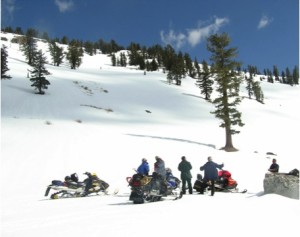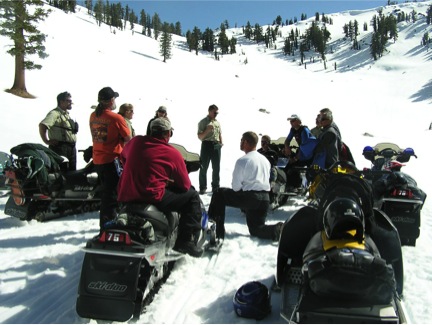Snowmobile use is a popular recreation activity in the Stanislaus Forest in years when it actually snows enough to cover the mountains. Snowshoe trekking and cross-county skiing are also popular, and rarely do the quiet recreation and noisy recreation uses overlap without causing conflicts and frustrations. CSERC staff has actually used snowmobiles in State Park areas to do winter wildlife photo-surveys. We’ve also ridden snowmobiles on a tour (at right) provided by pro-snowmobile interests as part of Forest Service dialogues about winter management planning. We’ve seen the annoyance that quiet recreation visitors feel when noisy snowmobiles come past on narrow snow-covered routes. But the issue that matters to CSERC the most is identifying the areas that are appropriate for snowmobile use and identifying other areas that should be left as non-motorized and free of noisy disturbance for wildlife. Currently the Stanislaus Forest is one of numerous forests that are developing new Over-Snow Vehicle management plans. Unfortunately, instead of looking where current motorized use is allowed and determining how to manage it to reduce conflicts, the Stanislaus Forest staff has actively encouraged snowmobilers to identify sites where they like to ride (illegally) in roadless wild places that are designated as off limits by the current Forest Plan. CSERC staff attended two Over- Snow Vehicle open houses and heard Forest staff discuss opening up off-limits roadless areas to snowmobile use. One area, the Pacific Valley roadless area, has had frequent snowmobile trespass for many years despite CSERC expressing frustration to two previous Forest Supervisors that the Forest is failing to enforce its very clear Land Management Plan regulations. Those frustrations have been shrugged off by supervisors who explained that no “Forest Orders” were ever adopted to penalize those who willfully trespass. Yet those same Forest Supervisors have then failed to take the needed action to adopt Forest Orders that would allow enforcement.
But the issue that matters to CSERC the most is identifying the areas that are appropriate for snowmobile use and identifying other areas that should be left as non-motorized and free of noisy disturbance for wildlife. Currently the Stanislaus Forest is one of numerous forests that are developing new Over-Snow Vehicle management plans. Unfortunately, instead of looking where current motorized use is allowed and determining how to manage it to reduce conflicts, the Stanislaus Forest staff has actively encouraged snowmobilers to identify sites where they like to ride (illegally) in roadless wild places that are designated as off limits by the current Forest Plan. CSERC staff attended two Over- Snow Vehicle open houses and heard Forest staff discuss opening up off-limits roadless areas to snowmobile use. One area, the Pacific Valley roadless area, has had frequent snowmobile trespass for many years despite CSERC expressing frustration to two previous Forest Supervisors that the Forest is failing to enforce its very clear Land Management Plan regulations. Those frustrations have been shrugged off by supervisors who explained that no “Forest Orders” were ever adopted to penalize those who willfully trespass. Yet those same Forest Supervisors have then failed to take the needed action to adopt Forest Orders that would allow enforcement.
Officially opening up a roadless area to motorized use can reduce chances to permanently preserve that wild area at some point in the future. Once anti-environmental legislators can point to legal motorized use occurring in an area, they can portray any wilderness designation as locking out the existing motorized use. But as long as a wild area is legally managed as non-motorized, its status as a potential wilderness area remains high. CSERC opposes allowing any snowmobile use in wild areas. We also believe that any USFS consideration of opening up roadless areas to use by snowmobiles should only be done as part of a Forest Plan analysis, not in an OSV Plan dominated by snowmobilers.


